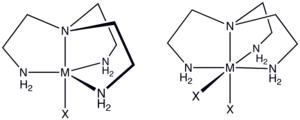Tris(2-aminoethyl)amine
amine.svg.png) | |
| Identifiers | |
|---|---|
| 4097-89-6 | |
| 3D model (Jmol) | Interactive image |
| 1739626 | |
| ChEBI | CHEBI:30631 |
| ChEMBL | ChEMBL19823 |
| ChemSpider | 70131 |
| ECHA InfoCard | 100.021.689 |
| EC Number | 223-857-4 |
| 27074 | |
| MeSH | tris(2-aminoethyl)amine |
| PubChem | [https://pubchem.ncbi.nlm.nih.gov/compound/77731 |
| RTECS number | KH8587082 |
| UN number | 2922 |
| |
| |
| Properties | |
| C6H18N4 | |
| Molar mass | 146.24 g·mol−1 |
| Appearance | Colourless liquid |
| Odor | Ichtyal, ammoniacal |
| Density | 977 mg mL−1 |
| Melting point | −16 °C (3 °F; 257 K) |
| Boiling point | 265 °C (509 °F; 538 K) |
| Miscible | |
| log P | −2.664 |
| Vapor pressure | 3 Pa (at 20 °C) |
| Refractive index (nD) |
1.497 |
| Thermochemistry | |
| Std enthalpy of formation (ΔfH |
−74.3–−72.9 kJ mol−1 |
| Std enthalpy of combustion (ΔcH |
−4860.6–−4859.2 kJ mol−1 |
| Hazards | |
| Safety data sheet | fishersci.com |
| GHS pictograms |   |
| GHS signal word | DANGER |
| H301, H310, H314 | |
| P280, P302+350, P305+351+338, P310 | |
| EU classification (DSD) |
|
| R-phrases | R22, R24, R34 |
| S-phrases | S26, S36/37/39 |
| Flash point | 113 °C (235 °F; 386 K) |
| Lethal dose or concentration (LD, LC): | |
| LD50 (median dose) |
|
| Related compounds | |
| Related amines |
|
| Related compounds |
|
| Except where otherwise noted, data are given for materials in their standard state (at 25 °C [77 °F], 100 kPa). | |
| | |
| Infobox references | |
Tris(2-aminoethyl)amine is the organic compound with the formula N(CH2CH2NH2)3. This colourless liquid is soluble in water and is highly basic, consisting of a tertiary amine center and three pendant primary amine groups. Abbreviated tren, it is the archetypal tripodal ligand of interest in coordination chemistry.
Tren is a C3-symmetric, tetradentate chelating ligand that forms stable complexes with transition metals, especially those in the 2+ and 3+ oxidation states. Tren complexes exist with relatively few isomers, reflecting the constrained connectivity of this tetramine. Thus, only a single achiral stereoisomer exists for [Co(tren)X2]+, where X is halide or pseudohalide.[1] In contrast, for [Co(trien)X2]+ five diastereomers are possible, four of which are chiral. In a few cases, tren serves as a tridentate ligand with one of the primary amine groups non-coordinated.

Related tripodal ligands
The permethylated derivative of tren is also well known. With the formula N(CH2CH2NMe2)3, "Me6tren," forms a variety of complexes but, unlike tren, does not stabilize Co(III). Related amino-triphosphines are also well developed, such as N(CH2CH2PPh2)3 (m.p. 101-102 °C). This species is prepared from the nitrogen mustard N(CH2CH2Cl)3.[2] Tren is a common impurity in the more common triethylenetetramine ("trien"). As a trifunctional amine, tren forms a triisocyanate when derivatized with COCl2.[3]
Safety considerations
(NH2CH2CH2)3N, like other polyamines, is corrosive.[4]
References
- ↑ Donald A. House "Ammonia & N-donor Ligands" in Encyclopedia of Inorganic Chemistry John Wiley & Sons, 2006. doi:10.1002/0470862106.ia009.
- ↑ R. Morassi, L. Sacconi "Tetradentate Tripod Ligands Containing Nitrogen, Sulfur, Phosphorus, and Arsenic as Donor Atoms" Inorganic Syntheses 1976, vol. 16 p. 174-180. doi:10.1002/9780470132470.ch47
- ↑ Pressure Chemical
- ↑ The Physical and Theoretical Chemistry Laboratory Oxford University MSDS